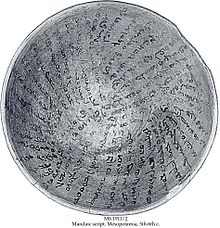- Incantation bowls
-
 Mandaic magical 'demon trap'
Mandaic magical 'demon trap'
Incantation Bowls, also known as demon bowls or devil trap bowls, are a form of early protective magic found in modern-day Iraq and Iran. Produced in the Middle East during the Late Antiquity from 6th to 8th century AD (see Asuristan),[1] the bowls were usually inscribed in a spiral beginning from the rim and moving towards the center. Most are inscribed in Aramaic languages. The bowls were buried face down and were meant to capture demons. They were commonly placed under the threshold, courtyards, in the corner of the homes of the recently deceased and in graveyards.[2]
Contents
In Judaism and Christianity
A subcategory of incantation bowls are those used in Jewish and Christian magical practice. (See Jewish magical papyri for context).
Sources
Further reading
- Gioia, Ted, "Healing songs", Format: Book, Electronic Resource 2006
- Juusola, Hannu, "Linguistic peculiarities in the Aramaic magic bowl texts", Format: Book, Electronic Resource, 1999.
- Levene, Dan, "A corpus of magic bowls : Incantation texts in Jewish Aramaic from late antiquity", format: Book, Electronic Resource, 2003.
- McCullough, William Stewart, "Jewish and Mandaean incantation bowls in the Royal Ontario Museum", 1967.
- Montgomery, James A., "Aramaic Incantation Texts from Nippur", 1913.
- Müller-Kessler, Christa, "Die Zauberschalentexte in der Hilprecht-Sammlung, Jena und weitere Nippur-Texte anderer Sammlungen", 2005.
- Naveh, Joseph and Shaked, Shaul, "Amulets and magic bowls : Aramaic incantations of late antiquity", 1985.
- Naveh, Joseph and Shaked, Shaul, “Magic Spells and Formulae : Aramaic Incantations of Late Antiquity", 1993.
External links
- Translation of an incantation bowl
- Rare Magic Inscription on Human Skull Biblical Archaeology Review
Categories:
Wikimedia Foundation. 2010.
